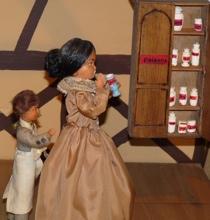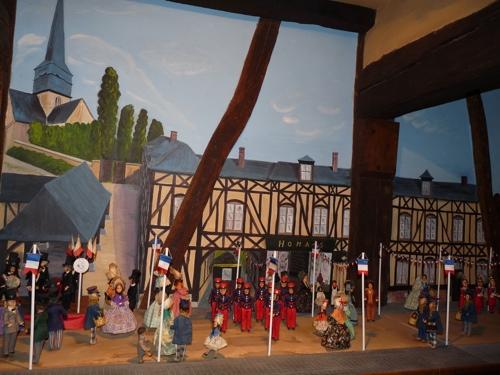
Yonville l’Abbaye, literature’s capital of provincial conformity, clichés, and idées reçues, was said by Flaubert to be “a place that does not exist.” But ever since Maxime du Camp, Flaubert’s friend and traveling companion, told the world that the germ of Madame Bovary was the scandalous death by suicide of Delphine Delamare, wife of the officer of health in the small market town of Ry, fiction and fact, Yonville and Ry, have become inseparably entwined.
A plaque on the church wall (put up in 1990 by the Fédération Nationale des Ecrivains de France, whose members might have been expected to be more circumspect about the fact-and-fiction business) memorializes Delamare (1822–1848) and Emma Bovary as the same woman. Other, older plaques, now fading, are posted at intervals on Ry’s long, sloping main street, announcing the sites of Homais’s pharmacy, the office of the lecherous notaire, Maitre Guillaumin, and so on. The Cadogan Guide to Normandy says that Le Bovary restaurant, now La Table d’Oscar, is the Café Français in Madame Bovary, that the Bovary residence “is now a lawyer’s office,” and that “the Crédit Agricole savings bank occupies the building that was the Hôtel de Rouen in Flaubert’s day, and the Hôtel Lion d’Or in the novel.”
How Flaubert would have sneered. Readers may sneer, too. What first strikes the literary tourist about Ry is how badly it conforms to the pastiche-guidebook description of Yonville that opens Part 2 of the novel. The street “about the length of a gunshot” fits if one unkinks its bend, but little else does. Ry is not “stretched out along the river bank like a cowherd taking a nap by the water’s edge”; its river (the Crevon, a trouty, gin-clear chalk stream) runs crossways to the town, and the bridge over it at the bottom of the street marks the town’s end. The positioning of the market square, the inn, the pharmacy are all wrong in relation to each other, and if you try to treat Ry as a life-size, three-dimensional Yonville, you quickly find yourself up against a diagonal timber-and-plaster wall.
That said, there are two features of Ry that nicely reinforce a reading of Madame Bovary. The town is only thirteen miles east of Rouen, but feels far further. It belongs to Normandy’s agricultural economy (hay wagons on the main street), and its air of provincial isolation from a city so nearby would be unimaginable in England, let alone the US Its self-containment, deep in fields of wheat and grazing Charolais and dairy cattle, makes Emma’s trips to Rouen in the Lion d’Or’s rattletrap coach, the Hirondelle, seem almost as momentous now as they were in 1850—journeys to a remote and glamorous world beyond the ken of the townsfolk of Yonville.
The second is the hilariously weird Musée d’Automates, housed in a restored cider press just short of the bridge. In 1977, an horloger, Michel Burgaud, and his young son installed their exhibition (“Une pléiade de couleurs et de vie”) of mechanical tableaux of scenes from Madame Bovary. At the press of a switch, three hundred stage-lit dolls, each eight or so inches high, swivel jerkily and saw the air as they act out the novel against painted backdrops that reshape Ry into the spitting image of Yonville.

Here’s Emma’s first taste of high life, at the Vaubyessard ball…here’s the wedding…here’s the agricultural show…here’s Hippolyte, having his leg amputated by Dr. Canivet after Charles Bovary’s botched operation on his club foot…here’s Emma, boating on the Seine with Léon…here she is, in Homais’s medicine room, gulping down arsenic. You can tell the men from the women by their clothes, hairstyles, and moustaches, but their brick-pink faces are identical, each one molded and painted in the same cheerfully vacant grin. Even Hippolyte, leg half sawn off and blood everywhere, contributes his share of imbecile good humor to the show.
Bad art has an important role in Flaubert’s novel. The Burgaud tableaux recall, with unconscious fidelity, the organ-grinder who shows up at Emma’s window in Tostes:
A waltz would begin and, on top of the barrel organ, in a tiny drawing room, dancers no taller than your finger—ladies in pink turbans, Tyroleans in jackets, monkeys in black tailcoats, gentlemen in knee breeches—circled round and round among the armchairs and tables and sofas, mirrored in pieces of glass held together at the edges by strips of gold paper.
This contrivance is sufficient to set the newlywed Emma dreaming miserably of theaters, salons, and dancing under chandeliers.
Then there’s Binet, old soldier, tax collector, captain of the fire brigade, and model of the artist as a bourgeois hobbyist, who spends every available hour up in his attic with his precious lathe, turning out ornate napkin rings—rough wooden copies of the intricate lacework of Dieppe ivories. Toward the end of the book, his labors become an explicit parody of Flaubert’s own work on Madame Bovary, as Binet approaches the finish of his masterpiece, a fantastical assembly of “crescents and hollowed-out spheres nestled one inside the other, the whole affair as upright as an obelisk and entirely useless”:
Advertisement
[He] seemed sunk in one of those states of perfect bliss which can probably only be induced by mediocre pursuits, occupations which challenge the intelligence with superficial difficulties, and satisfy it with a sense of achievement greater than which cannot even be imagined.
Where Binet left off, the Burgauds began. Innumerable hours of enthralled, obsessive, foolish devotion must have gone into their copying of Flaubert’s novel in wire, papier-maché, and clockwork—an artistic enterprise at once perfectly dotty and perfectly in keeping with the book. It’ll be hard to read Madame Bovary again without finding the Musée d’Automates on Yonville l’Abbaye’s main street.
Translations are from the Oxford World’s Classics edition of Madame Bovary, translated by Margaret Mauldon.


